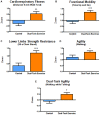Dual-Task Exercise to Improve Cognition and Functional Capacity of Healthy Older Adults
- PMID: 33679369
- PMCID: PMC7928356
- DOI: 10.3389/fnagi.2021.589299
Dual-Task Exercise to Improve Cognition and Functional Capacity of Healthy Older Adults
Abstract
Background: It has been suggested that physical inactivity and lack of stimulating cognitive activity are the two most significant modifiable risk factors to impair cognitive function. Although many studies that investigated the cognitive effects of physical exercise and cognitive stimuli in dual-task conditions showed improved cognitive performance, others have not confirmed these findings. The main aim of the present work is to analyze the effects of a dual-task multimodal physical exercise training, at moderate intensity, and cognitive stimulation on cognitive and physical function in healthy older adults.
Methods: This clinical trial was registered on the Brazilian Registry of Clinical Trials (RBR-9zrx3d). Here we tested the effects of a dual-task multimodal physical exercise training, at moderate intensity, on cognitive and physical function and quality of life in community dwelling older adults. The training protocol included 24 group sessions, 2/week, per 75 min. Cognition was assessed using CANTAB automated neuropsychological tests and Functional Capacity to Exercise tests. Performance was compared from baseline to post intervention and to a non-exercise control group using Mixed Linear Model for repeated measures.
Results: Control (CG) and dual-task (DTEx) groups progressed differentially over time on performance of episodic memory, sustained visual attention, functional mobility, cardiorespiratory fitness, lower limbs strength resistance, agility, quality of life and dual-task performance with significant improved DTEx performance. Control group did not show any significant changes on these tests except for showing a reduction in dual-task performance.
Conclusion: We suggest that the dual-task combination of multisensory cognitive stimulation and multimodal moderate physical exercise training, twice a week, may be adopted as an effective program to reduce progression of age-related cognitive decline and improve physical fitness and quality of life on healthy older adults.
Clinical trial registration: Brazilian Registry of Clinical Trials: https://ensaiosclinicos.gov.br/rg/RBR-9zrx3d -UTN code: U1111-1233-6349.
Keywords: aged; cognitive dysfunction; dual-task exercise; healthy aging; neuropsychological tests; physical fitness; physical therapy modalities; rehabilitation.
Copyright © 2021 Jardim, Bento-Torres, Costa, Carvalho, Pontes, Tomás, Sosthenes, Erickson, Bento-Torres and Diniz.
Conflict of interest statement
The authors declare that the research was conducted in the absence of any commercial or financial relationships that could be construed as a potential conflict of interest.
Figures




References
-
- Adcock M., Fankhauser M., Post J., Lutz K., Zizlsperger L., Luft A. R., et al. (2020). Effects of an in-home multicomponent exergame training on physical functions, cognition, and brain volume of older adults: a randomized controlled trial. Front. Med. 6:321. 10.3389/fmed.2019.00321 - DOI - PMC - PubMed
-
- Ansai J. H., de Andrade L. P., de Souza Buto M. S., Barroso V. A., Farche A. C. S., Rossi P. G., et al. (2017). Effects of the addition of a dual task to a supervised physical exercise program on older adults’ cognitive performance. J. Aging Phys. Activ. 25 234–239. 10.1123/japa.2016-0094 - DOI - PubMed
-
- Benedetti T. B., Mazo G. Z., de Barros M. V. G. (2004). Application of the international physical activity questionnaire (IPAQ) for evaluation of elderly women: concurrent validity and test-retest reprodutibility. R. Bras. Ci. Mov. 12 25–34. 10.18511/rbcm.v12i1.538 - DOI
LinkOut - more resources
Full Text Sources
Other Literature Sources

